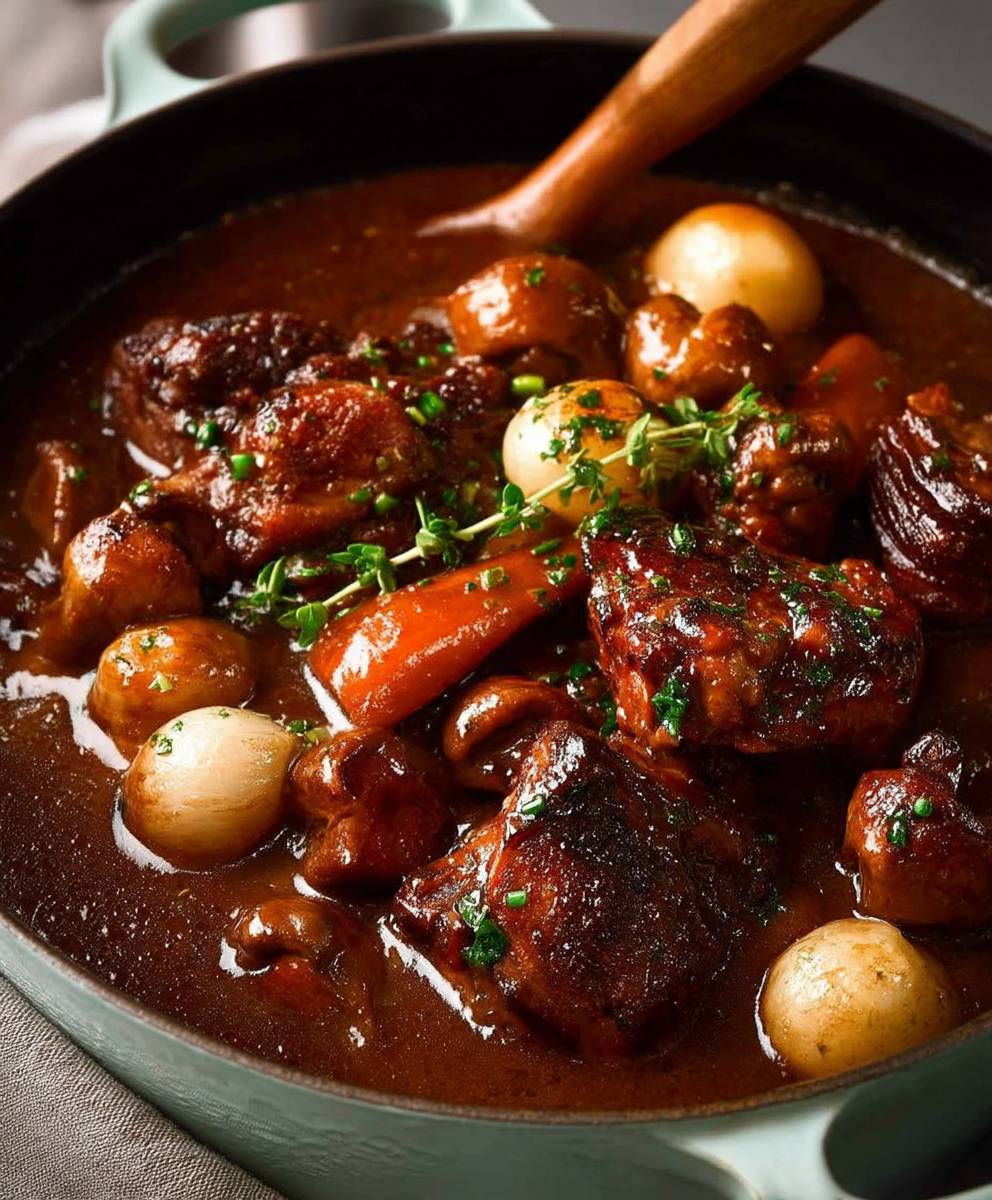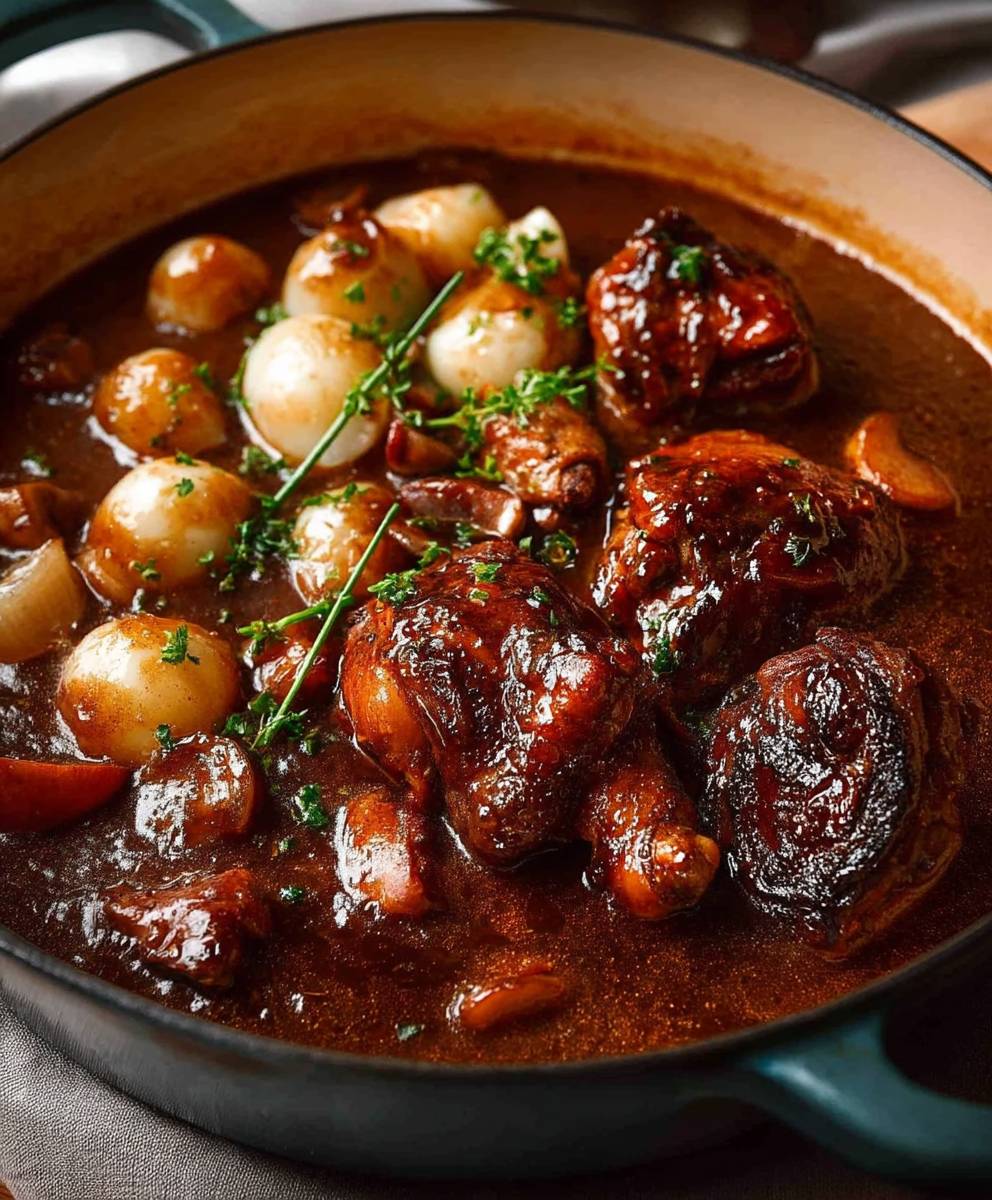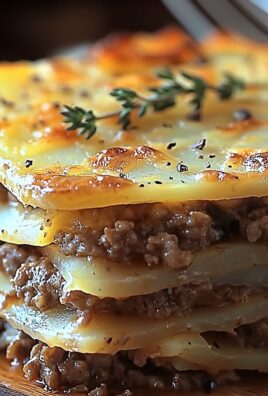Coq au Vin, the very name conjures images of rustic French kitchens, simmering pots, and the rich aroma of wine and herbs filling the air. Have you ever dreamed of creating a dish that’s both elegant and comforting, a true testament to culinary artistry? Well, look no further! This classic French braise, translating to “rooster in wine,” is more than just a recipe; it’s an experience.
The history of Coq au Vin is steeped in French tradition, with variations found throughout the country. While its exact origins are debated, many believe it originated as a way to tenderize older, tougher roosters. By braising the bird in wine, the meat becomes incredibly succulent and flavorful. This resourceful technique transformed a humble ingredient into a dish fit for royalty, and it remains a cornerstone of French cuisine to this day.
What makes Coq au Vin so beloved? It’s the symphony of flavors, the tender, melt-in-your-mouth chicken, and the deeply savory sauce. The combination of earthy mushrooms, smoky bacon (or lardons), aromatic vegetables, and, of course, the robust red wine creates a truly unforgettable culinary experience. It’s a dish that’s perfect for a special occasion, a cozy weeknight dinner, or anytime you want to impress your guests with your culinary prowess. Plus, while it may seem intimidating, with our easy-to-follow recipe, you’ll be surprised at how achievable this masterpiece is. Get ready to embark on a delicious journey and create your own unforgettable Coq au Vin!
Ingredients:
- Chicken: 3-4 lbs, cut into serving pieces (bone-in, skin-on preferred for flavor)
- Bacon: 6 oz, thick-cut, diced
- Onions: 2 medium, yellow, chopped
- Carrots: 2 medium, peeled and sliced
- Celery: 2 stalks, chopped
- Mushrooms: 1 lb, cremini or button, quartered
- Garlic: 4 cloves, minced
- All-Purpose Flour: 2 tablespoons
- Red Wine: 1 bottle (750ml), Burgundy or Pinot Noir recommended
- Chicken Broth: 2 cups, low sodium
- Tomato Paste: 2 tablespoons
- Thyme: 2 sprigs fresh, or 1 teaspoon dried
- Bay Leaf: 1
- Brandy: 1/4 cup (optional, for flambéing)
- Olive Oil: 2 tablespoons
- Butter: 2 tablespoons
- Salt: To taste
- Black Pepper: To taste
- Fresh Parsley: Chopped, for garnish
Preparing the Chicken and Vegetables:
- Prepare the Chicken: Pat the chicken pieces dry with paper towels. This is crucial for getting a good sear. Season generously with salt and pepper. Don’t be shy this is your only chance to season the chicken directly.
- Render the Bacon: In a large Dutch oven or heavy-bottomed pot over medium heat, cook the diced bacon until crispy. Remove the bacon with a slotted spoon and set aside, leaving the rendered bacon fat in the pot. We’ll use this flavorful fat to sear the chicken.
- Sear the Chicken: Increase the heat to medium-high. Working in batches (don’t overcrowd the pot!), sear the chicken pieces on all sides until golden brown. This usually takes about 3-4 minutes per side. Searing develops a beautiful crust and adds depth of flavor to the dish. Remove the chicken from the pot and set aside.
- Sauté the Vegetables: Add the chopped onions, carrots, and celery to the pot. Cook over medium heat, stirring occasionally, until the vegetables are softened, about 5-7 minutes. Scrape up any browned bits from the bottom of the pot these are packed with flavor!
- Add Mushrooms and Garlic: Add the quartered mushrooms and minced garlic to the pot. Cook, stirring occasionally, until the mushrooms are softened and have released their moisture, about 5-7 minutes.
Building the Coq au Vin:
- Dust with Flour: Sprinkle the flour over the vegetables and cook for 1 minute, stirring constantly. This will help thicken the sauce later on.
- Deglaze with Brandy (Optional): If using brandy, remove the pot from the heat. Carefully pour the brandy into the pot and, using a long match or lighter, ignite the brandy. Be very careful! The flames will subside quickly. This step adds a wonderful aroma and flavor, but it’s perfectly fine to skip it if you’re not comfortable with flambéing.
- Add Wine and Broth: Pour in the red wine and chicken broth. Bring the mixture to a simmer, scraping up any remaining browned bits from the bottom of the pot.
- Add Tomato Paste and Herbs: Stir in the tomato paste, thyme sprigs (or dried thyme), and bay leaf.
- Return Chicken to the Pot: Return the seared chicken pieces to the pot, nestling them into the sauce. Make sure the chicken is mostly submerged in the liquid.
Simmering and Finishing:
- Simmer: Bring the mixture to a gentle simmer, then reduce the heat to low, cover the pot, and simmer for 1 1/2 to 2 hours, or until the chicken is very tender and falling off the bone. Check the chicken periodically and add more chicken broth if the sauce is reducing too much.
- Remove Chicken: Carefully remove the chicken pieces from the pot and set aside.
- Reduce the Sauce: Increase the heat to medium and simmer the sauce, uncovered, for 15-20 minutes, or until it has thickened to your desired consistency. You can use a spoon to skim off any excess fat that rises to the surface.
- Adjust Seasoning: Taste the sauce and adjust the seasoning with salt and pepper as needed. Remember that the sauce will concentrate as it reduces, so be careful not to over-salt.
- Finish the Sauce: Stir in the butter to enrich the sauce and give it a glossy sheen.
- Return Chicken to Sauce: Return the chicken pieces to the pot and gently heat through.
- Add Bacon: Stir in the cooked bacon.
Serving Suggestions:
- Serve: Serve the Coq au Vin hot, garnished with fresh chopped parsley.
- Pairing: This dish is delicious served with mashed potatoes, egg noodles, crusty bread for soaking up the sauce, or roasted vegetables. A side salad also complements the richness of the dish.
- Wine Pairing: Serve with the same red wine you used in the recipe, such as a Burgundy or Pinot Noir. A Beaujolais or other light-bodied red wine would also be a good choice.
Tips for Success:
- Use good quality wine: Since the wine is a key ingredient, choose a bottle that you would enjoy drinking. Avoid using “cooking wine,” as it often contains additives and doesn’t have the same flavor as regular wine.
- Don’t overcrowd the pot when searing: Searing the chicken in batches ensures that it browns properly. Overcrowding the pot will lower the temperature and cause the chicken to steam instead of sear.
- Be patient when simmering: The long simmering time is essential for developing the rich, complex flavors of Coq au Vin. Don’t rush the process!
- Adjust the sauce to your liking: If you prefer a thicker sauce, you can whisk together a slurry of cornstarch and water (1 tablespoon cornstarch mixed with 2 tablespoons cold water) and stir it into the sauce during the last few minutes of simmering.
- Make it ahead: Coq au Vin actually tastes even better the next day, as the flavors have had time to meld together. You can make it a day or two in advance and store it in the refrigerator. Reheat gently before serving.
Variations:
- Vegetarian Coq au Vin: Substitute the chicken with hearty vegetables like mushrooms, butternut squash, and potatoes. Use vegetable broth instead of chicken broth.
- Coq au Riesling: Use a dry Riesling wine instead of red wine for a lighter, fruitier flavor.
- Add pearl onions: Add a cup of pearl onions to the pot along with the other vegetables for added flavor and texture.
- Use different herbs: Experiment with different herbs, such as rosemary or oregano, to customize the flavor of the dish.
Storage Instructions:
- Refrigerate: Store leftover Coq au Vin in an airtight container in the refrigerator for up to 3-4 days.
- Freeze: Coq au Vin can be frozen for up to 2-3 months. Thaw overnight in the refrigerator before reheating.
- Reheating: Reheat Coq au Vin gently in a saucepan over medium heat, or in the microwave. Add a splash of chicken broth or water if the sauce has thickened too much.

Conclusion:
This Honey Prawns recipe isn’t just another dish; it’s a guaranteed crowd-pleaser that will elevate your weeknight dinners or impress your guests at your next gathering. The perfect balance of sweet and savory, combined with the satisfying crunch of perfectly cooked prawns, makes it utterly irresistible. I truly believe this is a must-try recipe for anyone who loves Asian-inspired cuisine or simply enjoys a delicious and easy-to-make meal.
But why is it so special? It’s the simplicity! With just a handful of ingredients and minimal prep time, you can create a restaurant-quality dish in your own kitchen. The honey glaze, with its subtle hints of garlic and ginger, clings beautifully to the prawns, creating a symphony of flavors that will dance on your palate. And the best part? It’s incredibly versatile.
Serving Suggestions and Variations:
For a complete meal, serve these glistening Honey Prawns over a bed of fluffy jasmine rice or fragrant quinoa. The rice will soak up all that delicious honey sauce, ensuring no flavor goes to waste. Alternatively, you could toss them with some stir-fried noodles and vegetables for a more substantial dish. Think vibrant bell peppers, crisp snow peas, and crunchy bean sprouts the possibilities are endless!
If you’re feeling adventurous, why not try some variations? For a spicier kick, add a pinch of red pepper flakes to the honey glaze. Or, for a richer flavor, substitute some of the honey with maple syrup. You could even experiment with different types of prawns jumbo prawns for a more decadent experience, or smaller prawns for a quick and easy snack.
Another fantastic variation is to add a sprinkle of toasted sesame seeds and chopped green onions as a garnish. This not only adds a visual appeal but also enhances the nutty and savory notes of the dish. And if you’re looking for a lighter option, you can bake the prawns instead of pan-frying them. Simply toss them with the honey glaze and bake in a preheated oven until they’re cooked through and slightly caramelized.
Don’t be afraid to get creative and customize this recipe to your own taste preferences! That’s the beauty of cooking it’s all about experimenting and finding what you love.
I’m so confident that you’ll adore this Honey Prawns recipe that I urge you to give it a try. It’s the perfect dish for a quick weeknight meal, a casual weekend gathering, or even a special occasion. It’s guaranteed to be a hit with everyone, from picky eaters to seasoned foodies.
Once you’ve tried it, I’d absolutely love to hear about your experience! Did you make any variations? What did you serve it with? Did your family and friends enjoy it as much as I do? Please share your thoughts and photos in the comments below. Your feedback is invaluable and helps me to continue creating delicious and easy-to-follow recipes that you’ll love.
So, what are you waiting for? Gather your ingredients, put on your apron, and get ready to create some culinary magic. I promise you won’t be disappointed. Happy cooking, and I can’t wait to hear all about your Honey Prawns adventures! This recipe is truly a gem, and I’m thrilled to share it with you. Enjoy!
Coq au Vin: The Ultimate Guide to Making This Classic Dish
Classic French Coq au Vin: Chicken braised in red wine with bacon, mushrooms, and vegetables. A rich and flavorful dish perfect for a special occasion.
Ingredients
- Chicken: 3-4 lbs, cut into serving pieces (bone-in, skin-on preferred for flavor)
- Bacon: 6 oz, thick-cut, diced
- Onions: 2 medium, yellow, chopped
- Carrots: 2 medium, peeled and sliced
- Celery: 2 stalks, chopped
- Mushrooms: 1 lb, cremini or button, quartered
- Garlic: 4 cloves, minced
- All-Purpose Flour: 2 tablespoons
- Red Wine: 1 bottle (750ml), Burgundy or Pinot Noir recommended
- Chicken Broth: 2 cups, low sodium
- Tomato Paste: 2 tablespoons
- Thyme: 2 sprigs fresh, or 1 teaspoon dried
- Bay Leaf: 1
- Brandy: 1/4 cup (optional, for flambéing)
- Olive Oil: 2 tablespoons
- Butter: 2 tablespoons
- Salt: To taste
- Black Pepper: To taste
- Fresh Parsley: Chopped, for garnish
Instructions
- Prepare the Chicken: Pat the chicken pieces dry with paper towels. Season generously with salt and pepper.
- Render the Bacon: In a large Dutch oven or heavy-bottomed pot over medium heat, cook the diced bacon until crispy. Remove the bacon with a slotted spoon and set aside, leaving the rendered bacon fat in the pot.
- Sear the Chicken: Increase the heat to medium-high. Working in batches (don’t overcrowd the pot!), sear the chicken pieces on all sides until golden brown (3-4 minutes per side). Remove the chicken from the pot and set aside.
- Sauté the Vegetables: Add the chopped onions, carrots, and celery to the pot. Cook over medium heat, stirring occasionally, until the vegetables are softened (5-7 minutes). Scrape up any browned bits from the bottom of the pot.
- Add Mushrooms and Garlic: Add the quartered mushrooms and minced garlic to the pot. Cook, stirring occasionally, until the mushrooms are softened and have released their moisture (5-7 minutes).
- Dust with Flour: Sprinkle the flour over the vegetables and cook for 1 minute, stirring constantly.
- Deglaze with Brandy (Optional): If using brandy, remove the pot from the heat. Carefully pour the brandy into the pot and ignite the brandy using a long match or lighter. Be very careful! The flames will subside quickly.
- Add Wine and Broth: Pour in the red wine and chicken broth. Bring the mixture to a simmer, scraping up any remaining browned bits from the bottom of the pot.
- Add Tomato Paste and Herbs: Stir in the tomato paste, thyme sprigs (or dried thyme), and bay leaf.
- Return Chicken to the Pot: Return the seared chicken pieces to the pot, nestling them into the sauce. Make sure the chicken is mostly submerged in the liquid.
- Simmer: Bring the mixture to a gentle simmer, then reduce the heat to low, cover the pot, and simmer for 1 1/2 to 2 hours, or until the chicken is very tender and falling off the bone. Check the chicken periodically and add more chicken broth if the sauce is reducing too much.
- Remove Chicken: Carefully remove the chicken pieces from the pot and set aside.
- Reduce the Sauce: Increase the heat to medium and simmer the sauce, uncovered, for 15-20 minutes, or until it has thickened to your desired consistency. Skim off any excess fat that rises to the surface.
- Adjust Seasoning: Taste the sauce and adjust the seasoning with salt and pepper as needed.
- Finish the Sauce: Stir in the butter to enrich the sauce and give it a glossy sheen.
- Return Chicken to Sauce: Return the chicken pieces to the pot and gently heat through.
- Add Bacon: Stir in the cooked bacon.
- Serve: Serve the Coq au Vin hot, garnished with fresh chopped parsley.
Notes
- Use good quality wine that you would enjoy drinking.
- Don’t overcrowd the pot when searing the chicken.
- Be patient when simmering the dish.
- Adjust the sauce to your liking.
- Coq au Vin tastes even better the next day.
- Serve with mashed potatoes, egg noodles, crusty bread, or roasted vegetables.
- Pair with a Burgundy, Pinot Noir, or Beaujolais wine.





Leave a Comment